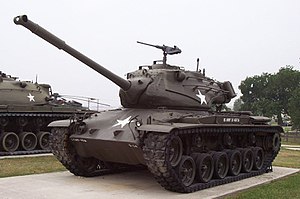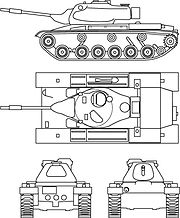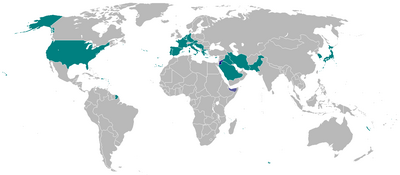| M47 Patton | |
|---|---|
 M47 Patton on display | |
| Type | Medium Tank[1] |
| Place of origin | United States |
| Service history | |
| In service | 1952 - 1989? (USA) |
| Production history | |
| Manufacturer |
Detroit Arsenal Tank Plant American Locomotive Co. |
| Produced | 1951 - 1953 |
| No. built | 8,576 |
| Specifications | |
| Mass | 46 tonnes (50.7 short tons) combat ready |
| Length | 27 ft 11 in (8.51 m) |
| Width | 11 ft 6.25 in (3.51 m) |
| Height | 11 ft (3.35 m) |
| Crew | 5 (commander, gunner, loader, driver, assistant driver) |
|
| |
| Armor | 4 in (100 mm) |
Main armament |
90 mm gun M36 71 rounds |
Secondary armament |
0.5 in (12.7 mm) M2 machine gun 2 × 7.62 mm machine gun |
| Engine |
Continental AVDS-1790-5B V12, air-cooled, Twin-turbo gasoline engine 810 hp (600 kW) |
| Power/weight | 17.6 hp/tonne |
| Transmission | General Motors CD-850-4, 2 ranges forward, 1 reverse |
| Suspension | Torsion bar |
| Fuel capacity | 231.94 gallons (878 liters) |
Operational range | 81 mi (130 km) |
| Maximum speed | 30 mph (48 km/h) |
| ||||||||||||||
| ||||||||||||||||||||

Line drawing of the M47.
The M47 Patton was the second tank of the Patton series, and one of the U.S Army's principal medium gun tanks of the Cold war with models in service from the early 1950s to the late 1980s. The tank belongs to the Patton family of tanks, named after General George S. Patton, commander of the U.S. Third Army during World War II and one of the earliest American advocates for the use of tanks in battle. It was a further development of the M46 Patton tank.
History[]
The M47 was the U.S. Army and Marine Corps primary tank, intended to replace the M46 Patton and M4 Sherman tanks. The M47 was widely used by U.S. Cold War allies, both SEATO and NATO countries, and was the only Patton series tank that never saw combat while in US service.
Although roughly similar (from a distance) to the later M48s and M60s, these were completely new tank designs. Many different M47 Patton models remain in service internationally. The M47 was the last US tank to have a bow-mounted machine gun in the hull.
Design[]
Although a new power plant corrected the mobility and reliability problems of the M26 Pershing, the subsequently renamed M46 was considered a stopgap solution that would be replaced later by the T42 medium tank. However, after fighting erupted in Korea, the Army decided it needed the new tank earlier than planned. It was deemed that there was not enough time to finish the development of the T42 and fix various problems that were likely to emerge in a new design. The final decision was to produce another interim solution, with the turret of the T42 mounted on the familiar hull of the M46. The composite tank, developed by the Detroit Arsenal, was named M47 Patton and entered production in 1951. Its main gun was the M36 90 mm gun with an M12 optical rangefinder fitted. The secondary armament consisted of two .30cal Brownings, one bow machine gun in the hull and one coaxial machine gun in the turret, and a .50cal Browning M2 on a pintle mount on the turret roof. The T42 turret had a larger turret ring than the M26/M46 turret, and featured a needle-nose design which improved armor protection of the turret front (similar to the M60A1 tank of 1962), an elongated turret bustle and storage bin which protruded halfway across the engine deck, and the turret sides were sloped to further improve ballistic protection; this gave the turret a decidedly lozenge-shaped profile. It also featured the M12 stereoscopic rangefinder, which was designed to improve first-round hit probability but proved difficult to use; the rangefinder protruded from both sides of the upper turret front, which would be a feature of American tanks until the advent of the M1 Abrams in 1980.[2]
Production began at the Detroit Tank Arsenal in June 1951 before the M47 was standardized for production. Delays in shipment of the M12 rangefinder and other problems due to the rushed production schedule caused a protracted testing period, and the first M47s were not fielded to the 1st and 2nd Armored Divisions until summer 1952. Standardized in May 1952, the M47 Patton's production ran until November 1953; Detroit built 5,481 tanks, and American Locomotive Company (Alco) produced 3,095, for a total production run of 8,576 M47 Pattons.[3]
Deployment[]
With the arrival of the improved M48 Patton in 1953, the M47 was declared limited standard in 1955 and were replaced with the M48 series in tank units soon after.[4] After being declared obsolete in 1957, M46s and M47s were retained in active duty infantry division battlegroup assault gun platoons (four tanks each, one platoon per battlegroup, for a total of 20 tanks per division) until replaced with the light truck mounted SS-10 anti-tank guided missile in the early 1960s.[5] M47s were used by the Reserves for a relatively short time, soon being replaced by early production M48 Patton series tanks; thus, most of the M47s were exported in the late 1950s.[6][7]
The US Marine Corps also fielded M47s starting in late 1952; after the Korean War, all seven Marine tank battalions, three divisional, two reserve training, and two force level, all fielded M47s. But these were soon replaced with M48A1 Pattons and M103 heavy tanks, with the last M47s being retired in 1959.[8]
The M47 was widely used by NATO and SEATO allies as well as other countries, including Austria (147), Belgium (784), Ethiopia (30), France (856), Greece (300 plus over 30 from West Germany), Iran (around 400), Italy (2,480), Japan (1 for evaluation only), Jordan (49), Pakistan (230), Portugal (161), Saudi Arabia (23 from the US, 108 on the international market), Somalia (25 from Saudi Arabia), South Korea (531), Sudan (17 from Saudi Arabia), Spain (389), Switzerland (2 for evaluation), Turkey (1,347 from the US and West Germany), West Germany (1,120), and Yugoslavia (319).[9] Like the US Army of the time, the West German Bundeswehr also used some of their M47s as interim tank destroyers/assault guns until replaced by the Raketenjagdpanzer 1 tank destroyers armed with SS-11 anti-tank guided missiles in the early 1960s.[10]
US Army M47s remaining in storage were expended as targets; in the 1970s, they were used for the M60A1's 105 mm (4.1 in) gun with devastating effect. The 105 mm HEAT round would penetrate the frontal armor with ease. Many M47s in like-new condition met their fate in this manner, showing the M60 crews first hand the effects of modern tank weapons on conventional steel armor.
Combat service[]
The M47 was used by the Turkish Army, in the Turkish invasion of Cyprus in July and August 1974, with an estimated 200 or more Pattons involved in the action. At least one operational M47, number 092273, was captured intact by the Cypriot National Guard and was reported to be still in service as late as 1993.[11]
The M47 was used by Jordan in the Six Day War in 1967. Pakistan used M47s against India in the Indo-Pakistani War of 1965. Iran used Pattons against Iraq in the Iran-Iraq war.
Croatia used M47s against the Serbs in the Croatian War of Independence but their performance was inferior to that of the Soviet T-55s. The Pattons were retired from service immediately after the war, and are now used as gunnery/missile targets during military exercises.
Variants[]
- M46E1 - pilot model, M46 hull with T42 turret, fitted with the M36 90 mm Gun, and was longer to incorporate a radio, ventilator, and featured a stereoscopic rangefinder; only one built[12]
- M47 - main production version, M46 hull modified with redesigned glacis, reduction from five to three track return rollers per side, longer mufflers on rear fenders; 8,576 built[13]
- M47M - The product of an improvement program started in the late 1960s, the M47M featured the engine and fire control elements from the M60A1. The assistant driver's position was eliminated in favor of additional 90 mm ammunition. Not used by the US; over 800 vehicles were produced for Iran and Pakistan[14]
- M47ER3 - Spanish armored recovery vehicle.
Additional Equipment
- M6 - Earth Moving Tank Mounting Bulldozer. Bulldozer kit for the M47 series.
Operators[]

Former users of the M47 in dark cyan, current users in dark blue
Former operators[]
 Austria
Austria Belgium
Belgium Croatia - Over 20 during the Croatian War of Independence, 16 units remained in service by 1996 but were soon retired.
Croatia - Over 20 during the Croatian War of Independence, 16 units remained in service by 1996 but were soon retired. Cyprus - One captured vehicle.
Cyprus - One captured vehicle.France
 Greece
Greece Iraq - All destroyed or scrapped.
Iraq - All destroyed or scrapped. Iran - 168 (includes M48)
Iran - 168 (includes M48) Italy
Italy Japan - Evaluation only.
Japan - Evaluation only. Republic of Korea - retired in 2006 ~ 2007
Republic of Korea - retired in 2006 ~ 2007 Pakistan
Pakistan Portugal
Portugal Saudi Arabia
Saudi Arabia Spain
Spain- United States
 West Germany
West Germany Turkey -Target and Plane Target
Turkey -Target and Plane Target Yugoslavia Total of 319 delivered during 1950s
Yugoslavia Total of 319 delivered during 1950s
See also[]
- M26 Pershing
- M46 Patton
- M48 Patton
- Type 61
- M60 Patton
- List of armoured fighting vehicles
- M103 heavy tank
- G-numbers SNL G262
References[]
- ↑ Hunnicutt, p. 35
- ↑ Jim Mesko "Pershing/Patton in action" ISBN 0-89747-442-2 pp. 41-45.
- ↑ Mesko, p. 41.
- ↑ Mesko, p. 47.
- ↑ Department of the Army, "Field Manual FM 7-21 Headquarters and Headquarters Company Infantry Division Battle Group", 8 August 1957, pp. 185, 205.
- ↑ Mesko, p. 47.
- ↑ Steven J. Zaloga "The M47 and M48 Patton Tanks" ISBN 1-85532-825-9 pp. 6, 12-38, 44-45.
- ↑ George F. Hofmann and Donn A. Starry "Camp Colt to Desert Storm: The History of U.S. Armored Forces" ISBN 0-8131-2130-2 p. 281.
- ↑ Zaloga, ibid.
- ↑ Peter Blume, "Die Anfangsjahre des Heeres 1956-1966", Tankograd Publishing 2003, pp. 46-47.
- ↑ The Action of the Captured M47 in Atilla II, Savvas Vlassis
- ↑ Mesko, pp.41,43
- ↑ Mesko, p.41
- ↑ Mesko, pp.41,43,45
Bibliography[]
- Hunnicutt, R. P. "Patton: A History of the American Main Battle Tank." (Vol 1), 1984, Presidio Press; ISBN 0-89141-230-1.
External links[]
| Wikimedia Commons has media related to Patton tank. |
- AFV Database: M47 Patton
- GlobalSecurity.org: M47 Patton
- Patton-Mania
- M47 Photos and Walk Arounds on Prime Portal
The original article can be found at M47 Patton and the edit history here.